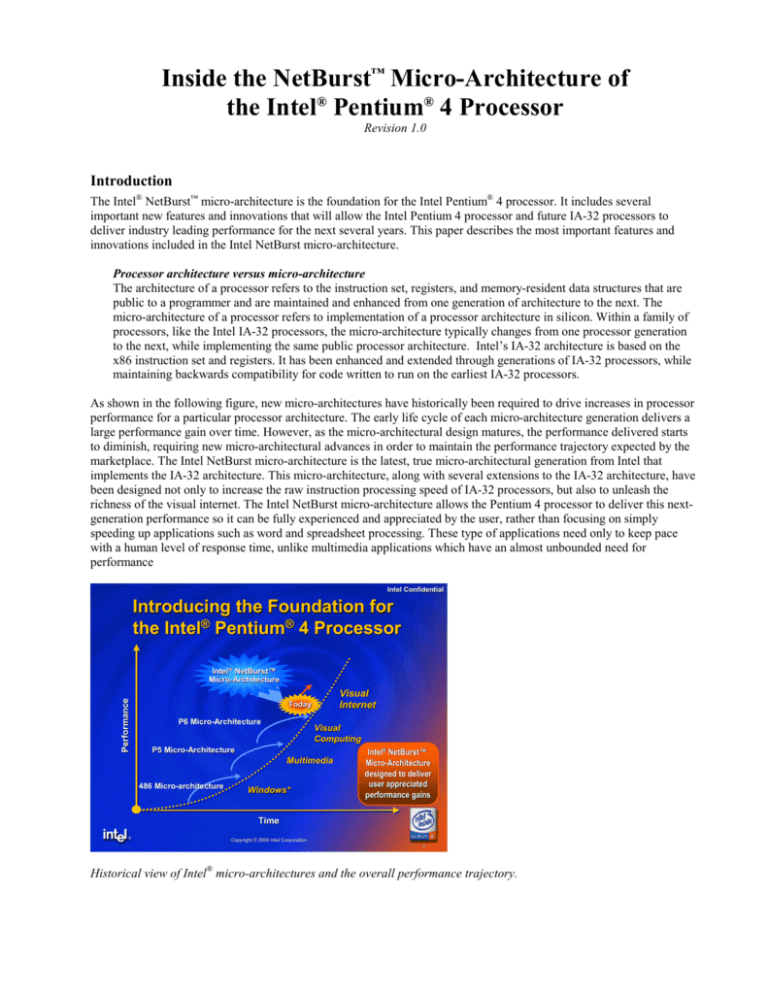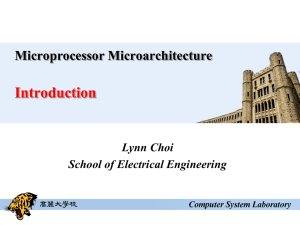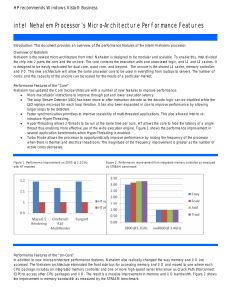
Inside the NetBurst™ Micro-Architecture of
the Intel® Pentium® 4 Processor
Revision 1.0
Introduction
The Intel® NetBurst™ micro-architecture is the foundation for the Intel Pentium® 4 processor. It includes several
important new features and innovations that will allow the Intel Pentium 4 processor and future IA-32 processors to
deliver industry leading performance for the next several years. This paper describes the most important features and
innovations included in the Intel NetBurst micro-architecture.
Processor architecture versus micro-architecture
The architecture of a processor refers to the instruction set, registers, and memory-resident data structures that are
public to a programmer and are maintained and enhanced from one generation of architecture to the next. The
micro-architecture of a processor refers to implementation of a processor architecture in silicon. Within a family of
processors, like the Intel IA-32 processors, the micro-architecture typically changes from one processor generation
to the next, while implementing the same public processor architecture. Intel’s IA-32 architecture is based on the
x86 instruction set and registers. It has been enhanced and extended through generations of IA-32 processors, while
maintaining backwards compatibility for code written to run on the earliest IA-32 processors.
As shown in the following figure, new micro-architectures have historically been required to drive increases in processor
performance for a particular processor architecture. The early life cycle of each micro-architecture generation delivers a
large performance gain over time. However, as the micro-architectural design matures, the performance delivered starts
to diminish, requiring new micro-architectural advances in order to maintain the performance trajectory expected by the
marketplace. The Intel NetBurst micro-architecture is the latest, true micro-architectural generation from Intel that
implements the IA-32 architecture. This micro-architecture, along with several extensions to the IA-32 architecture, have
been designed not only to increase the raw instruction processing speed of IA-32 processors, but also to unleash the
richness of the visual internet. The Intel NetBurst micro-architecture allows the Pentium 4 processor to deliver this nextgeneration performance so it can be fully experienced and appreciated by the user, rather than focusing on simply
speeding up applications such as word and spreadsheet processing. These type of applications need only to keep pace
with a human level of response time, unlike multimedia applications which have an almost unbounded need for
performance
Intel Confidential
Introducing the Foundation for
the Intel® Pentium® 4 Processor
Performance
Intel® NetBurst™
MicroMicro-Architecture
Visual
Internet
Today
P6 MicroMicro-Architecture
Visual
Computing
P5 MicroMicro-Architecture
Multimedia
486 MicroMicro-architecture
Windows*
Intel® NetBurst™
MicroMicro-Architecture
designed to deliver
user appreciated
performance gains
Time
Copyright © 2000 Intel Corporation
7
Historical view of Intel® micro-architectures and the overall performance trajectory.
What Determines True Processor Performance?
The only measure of performance that really matters is the amount of time it takes to execute a given application.
Contrary to a popular misconception, it is not clock frequency (MHz) alone or the number of instructions executed per
clock (IPC) alone that equates to performance. True performance is a combination of both clock frequency (MHz) and
IPC:
Performance = MHz x IPC
This shows that the performance can be improved by increasing frequency, IPC or optimally both. It turns out that
frequency is a function of both the manufacturing process and the micro-architecture. At a given clock frequency, the
IPC is a function of processor micro-architecture and the specific application being executed. Although it is not always
feasible to improve both the frequency and the IPC, increasing one and holding the other close to constant with the prior
generation can still achieve a significantly higher level of performance.
In addition to the two methods of increasing performance described above, it is also possible to increase performance by
reducing the number of instructions that it takes to execute the specific task being measured. Single Instruction Multiple
Data (SIMD) is a technique used to accomplish this. Intel first implemented 64-bit integer SIMD instructions in 1996 on
the Pentium® processor with MMX™ technology and subsequently introduced 128bit SIMD single precision floating
point (SSE) on the Pentium III processor
Applications can be broadly divided into two categories: integer/basic office productivity applications, and floating
point/multimedia applications. The IPC achievable by these different application categories varies greatly, and this
variance is strongly affected by the number of branches that the application code typically takes and the predictability of
these branches. The more branches taken that are difficult to predict, the higher the possibility of mis-predicting and
performing nonproductive work.
Integer and basic office productivity applications, such as word and spreadsheet processing, tend to have many
branches in the code that are difficult to predict, thus reducing overall IPC potential. As a result, performance increases
on these applications are more resistant to improvements in micro-architectural means, such as deeper pipelines. Also,
significantly raising the performance level on these types of applications does not necessarily increase the user’s
experience, as these types of applications only need to keep pace with the human level of read and write response time
and today’s higher end Pentium III processors satisfy this requirement.
Floating point and multimedia applications tend to have branches that are very predictable, and thus naturally have a
higher average IPC potential. As a result, these types of applications generally scale very well with frequency and are
inclined to benefit greatly from deeper pipelines. In addition, the processing power required by these applications tends
to be unbounded: the more performance that is available, the better the user’s experience.
The NetBurst Micro-Architecture of the Intel Pentium 4 Processor
The Pentium 4 processor, utilizing the NetBurst micro-architecture, is a complete processor re-design that delivers new
technologies and capabilities while advancing many of the innovative features, such as “out-of-order speculative
execution” and “super-scalar execution”, introduced on prior Intel micro-architectural generations. Many of these new
innovations and advances were made possible with the improvements in processor technology, process technology and
circuit design and could not previously be implemented in high-volume, manufacturable solutions. The features and
resulting benefits of the new micro-architecture are defined in the following sections.
Designed for Performance
A focused architectural definition effort was used to study the benefits of many advanced processor technologies and
determine the best approach to improve the overall performance of the processor for many years to come. The result of
this definition effort was a micro-architecture that significantly increased frequency capabilities to well above 40%
higher than that of the P6 micro-architecture (on the same manufacturing process) while maintaining an average IPC that
was within approximately 10% to 20% of the P6 micro-architecture. In this design, although the IPC is lower, the
increase in frequency capability more than makes up (Performance = frequency x IPC) and delivers overall higher
performance capability to the end user. This was done in the NetBurst micro-architecture by implementing a hyperpipelined technology where the depth of the pipeline was doubled from that of the P6 micro-architectural generation.
Although this deeper pipeline delivers significantly higher levels of frequency, the potential performance impacts
associated with the longer pipeline were comprehended and overcome in the design. The design effort focused on the
following:
2
•
Minimizing the Penalty Associated with Branch Mis-predicts
Explanation of Branch Mis-predict Penalty: As with the P6 generation, the NetBurst micro-architecture takes
advantage of out-of-order, speculative execution. This is where the processor routinely uses an internal branch
prediction algorithm to predict the result of branches in the program code and then speculatively executes
instructions down the predicted code branch. Although branch prediction algorithms are highly accurate, they
are not 100% accurate. If the processor mis-predicts a branch, all the speculatively executed instructions must
be flushed from the processor pipeline in order to restart the instruction execution down the correct program
branch. On more deeply pipelined designs, more instructions must be flushed from the pipeline, resulting in a
longer recovery time from a branch mis-predict. The net result is that applications that have many, difficult to
predict, branches will tend to have a lower average IPC.
Minimization of mis-predict penalty: To minimize the branch mis-prediction penalty and maximize the average
IPC, the deeply pipelined NetBurst micro-architecture greatly reduces the number of branch mis-predicts and
provides a quick method of recovering from any branches that have been mis-predicted. To minimize this
penalty, the NetBurst micro-architecture has implemented an Advanced Dynamic Execution engine and an
Execution Trace Cache. These features are both described later in this paper.
•
Keeping the High-Frequency Execution Units Busy (vs. Sitting Idle)
Although a processor may have a high frequency capability, it must provide a means to ensure that the
execution units (integer and floating point) are continually being supplied with instructions for execution. This
ensures that these high-frequency units are executing instructions (not sitting idle). With the high frequency of
these execution units in the NetBurst micro-architecture and the implementation of the Rapid Execution
Engine, where the Arithmetic Logic Units are running at two times the core frequency, Intel has implemented a
number of features that ensure that these execution units have a continuous stream of instructions to execute.
Intel has implemented a 400-MHz system bus, an Advanced Transfer Cache, an Execution Trace Cache, an
Advanced Dynamic Execution engine and a low-latency Level 1 Data Cache. These features work together to
quickly provide instructions and data to the processor’s high-performance execution units, thus keeping them
executing code instead of just idling at high frequency.
•
Reducing the Number of Instructions Needed to Complete a Task or Program
Many applications often perform repetitive operations on large sets of data. Further, the data sets involved in
these operations tend to be small values that can be represented with a small number of bits. These two
observations can be combined to improve application performance by both compactly representing data sets and
by implementing instructions that can operate in these compact data sets. This type of operation is called Single
Instruction Multiple Data (SIMD) and can reduce the overall number of instructions that a program is required
to execute. The NetBurst micro-architecture implements 144 new SIMD instructions, called Streaming SIMD
Extensions 2 (SSE2). The SSE2 instruction set enhances the SIMD instructions previously delivered with
MMX technology and SSE technology. These new instructions support 128-bit SIMD integer operations and
128-bit SIMD double-precision floating-point operations. By doubling the amount of data on which a given
instruction can operate, only half the number of instructions in a code loop need to be executed.
Intel NetBurst Micro-architecture Feature Details
Hyper-Pipelined Technology: The hyper-pipelined technology of the NetBurst micro-architecture doubles the pipeline
depth, compared to the P6 micro-architecture. One of the key pipelines, the branch prediction/recovery pipeline, is
implemented with a 20 stage pipeline in the NetBurst micro-architecture, compared to the equivalent pipeline in the P6
micro-architecture, which was implemented with a 10 stage pipeline. This technology significantly increases processor
performance and frequency scalability of the base micro-architecture.
Execution Trace Cache: The Execution Trace Cache is an innovative way to implement a Level 1 instruction cache. It
caches decoded x86 instructions (micro-ops), thus removing the latency associated with the instruction decoder from the
main execution loops. In addition, the Execution Trace Cache stores these micro-ops in the path of program execution
flow, where the results of branches in the code are integrated into the same cache line. This increases the instruction flow
from the cache and makes better use of the overall cache storage space (12K micro-ops) since the cache no longer stores
instructions that are branched over and never executed. The result is a means to deliver a high volume of instructions to
the processor’s execution units and a reduction in the overall time required to recover from branches that have been mispredicted.
3
Rapid Execution Engine: Through a combination of architectural, physical and circuit designs, the simple Arithmetic
Logic Units (ALUs) within the processor run at two times the frequency of the processor core. This allows the ALUs to
execute certain instructions with a latency that is ½ the duration of the core clock and results in higher execution
throughput as well as reduced latency of execution.
400-MHz System Bus: Through a physical signaling scheme of quad pumping the data transfers over a 100-MHz
clocked system bus and a buffering scheme allowing for sustained 400-MHz data transfers, the Pentium 4 processor
supports Intel’s highest performance desktop system bus delivering 3.2GB of data per second in and out of the processor.
This compares to 1.06GB/s delivered on the Pentium III processor’s 133-MHz system bus.
Advanced Dynamic Execution: The Advanced Dynamic Execution engine is a very deep, out-of-order speculative
execution engine that keeps the execution units executing instructions. It does so by providing a very large window of
instructions from which the execution units can choose. The large out-of-order instruction window allows the processor
to avoid stalls that can occur while instructions are waiting for dependencies to resolve. One of the more common forms
of stalls is waiting for data to be loaded from memory on a cache miss. This aspect is very important in high frequency
designs, as the latency to main memory increases relative to the core frequency. The NetBurst micro-architecture can
have up to 126 instructions in this window (in flight) vs. the P6 micro-architecture’s much smaller window of 42
instructions.
The Advanced Dynamic Execution engine also delivers an enhanced branch prediction capability that allows the
Pentium 4 processor to be more accurate in predicting program branches. This has the net effect of reducing the number
of branch mis-predictions by about 33% over the P6 generation processor’s branch prediction capability. It does this by
implementing a 4KB branch target buffer that stores more detail on the history of past branches, as well as by
implementing a more advanced branch prediction algorithm. This enhanced branch prediction capability is one of the
key design elements that reduce the overall sensitivity of the NetBurst micro-architecture to the branch mis-prediction
penalty.
Advanced Transfer Cache: The Level 2 Advanced Transfer Cache is 256KB in size and delivers a much higher data
throughput channel between the Level 2 cache and the processor core. The Advanced Transfer Cache consists of a 256bit (32-byte) interface that transfers data on each core clock. As a result, a 1.4-GHz Pentium 4 processor can deliver a
data transfer rate of 44.8GB/s (32 bytes x 1 (data transfer per clock) x 1.4 GHz = 44.8GB/s). This compares to a transfer
rate of 16GB/s on the Pentium III processor at 1 GHz and contributes to the Pentium 4 processor’s ability to keep the
high-frequency execution units executing instructions vs. sitting idle.
Streaming SIMD Extensions 2 (SSE2): With the introduction of SSE2, the NetBurst micro-architecture now extends the SIMD
capabilities that MMX technology and SSE technology delivered by adding 144 new instructions that deliver 128-bit SIMD
integer arithmetic operation and 128-bit SIMD Double-Precision Floating Point. These new instructions deliver the capability to
reduce the overall number of instructions required to execute a particular program task and as a result can contribute to an overall
performance increase. They accelerate a broad range of applications, including video, speech, and image, photo processing,
encryption, financial, engineering and Scientific Applications.
Resultant Performance Expectations
The Pentium 4 processor shows immediate performance improvements across most existing software applications
available today, with performance levels varying depending on the application category type and the application’s
tendency to execute instructions and instruction sequences that are optimally executed on the new micro-architecture.
Over time, as more applications are optimized, either specifically for the micro-architecture via assembler-level
optimizations, or are revised using the latest NetBurst micro-architecture optimized compilers and libraries, we will
continue to see even greater levels of performance scaling when the software runs on the Pentium 4 processor.
In summary, the Pentium 4 processor, based upon the NetBurst micro-architecture, delivers an acceleration of performance
across the applications and usages where users will truly be able to experience and appreciate it. These usages include: 3D
visualization, gaming, video, speech, and image photo processing, encryption, financial, engineering and Scientific
Applications.
© 2000 Intel Corporation. All rights reserved. Intel, the Intel logo, and Pentium are registered trademarks and MMX and NetBurst are trademarks of Intel Corporation.
Other brands and names are the property of their respective owner
4







